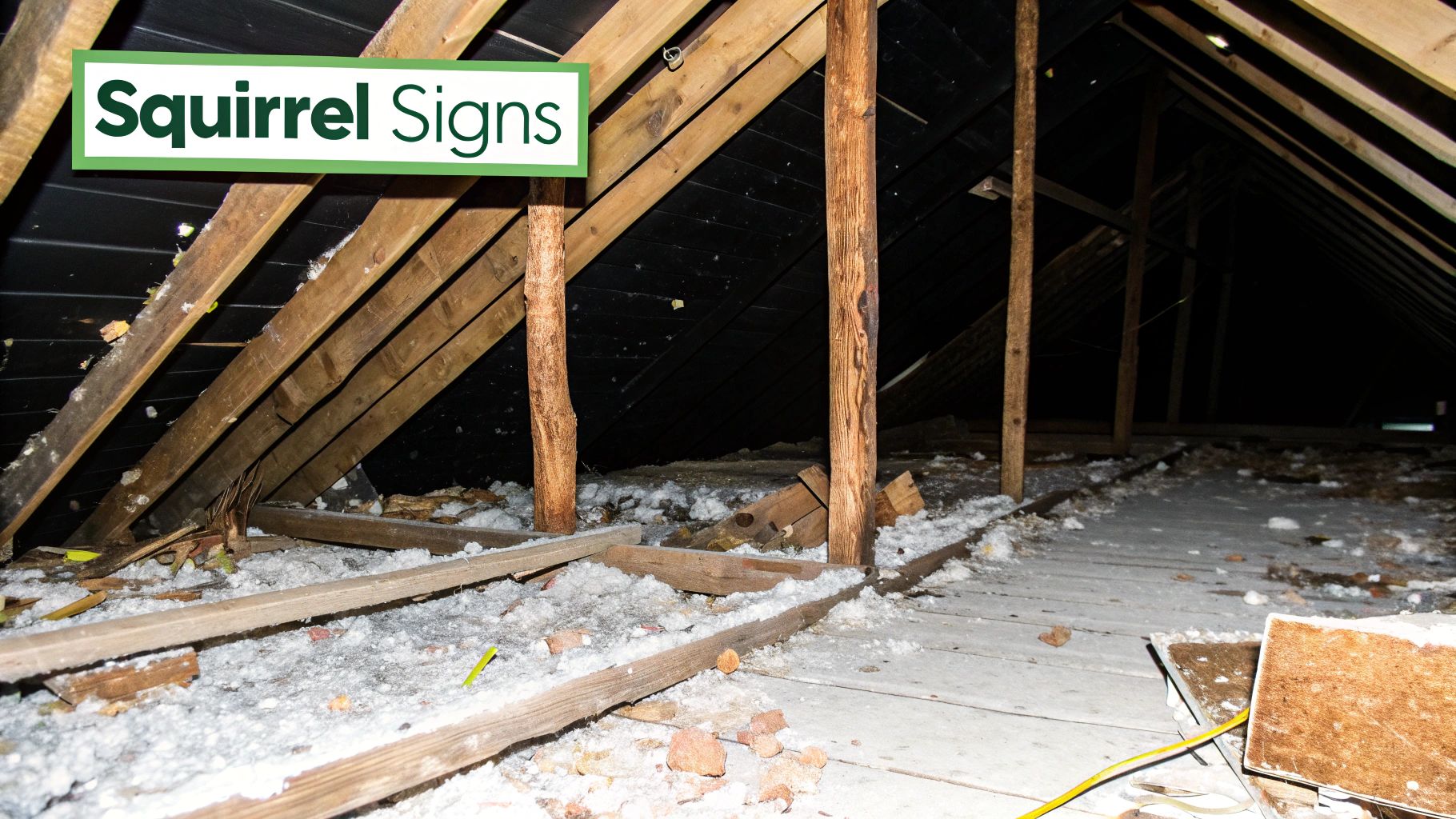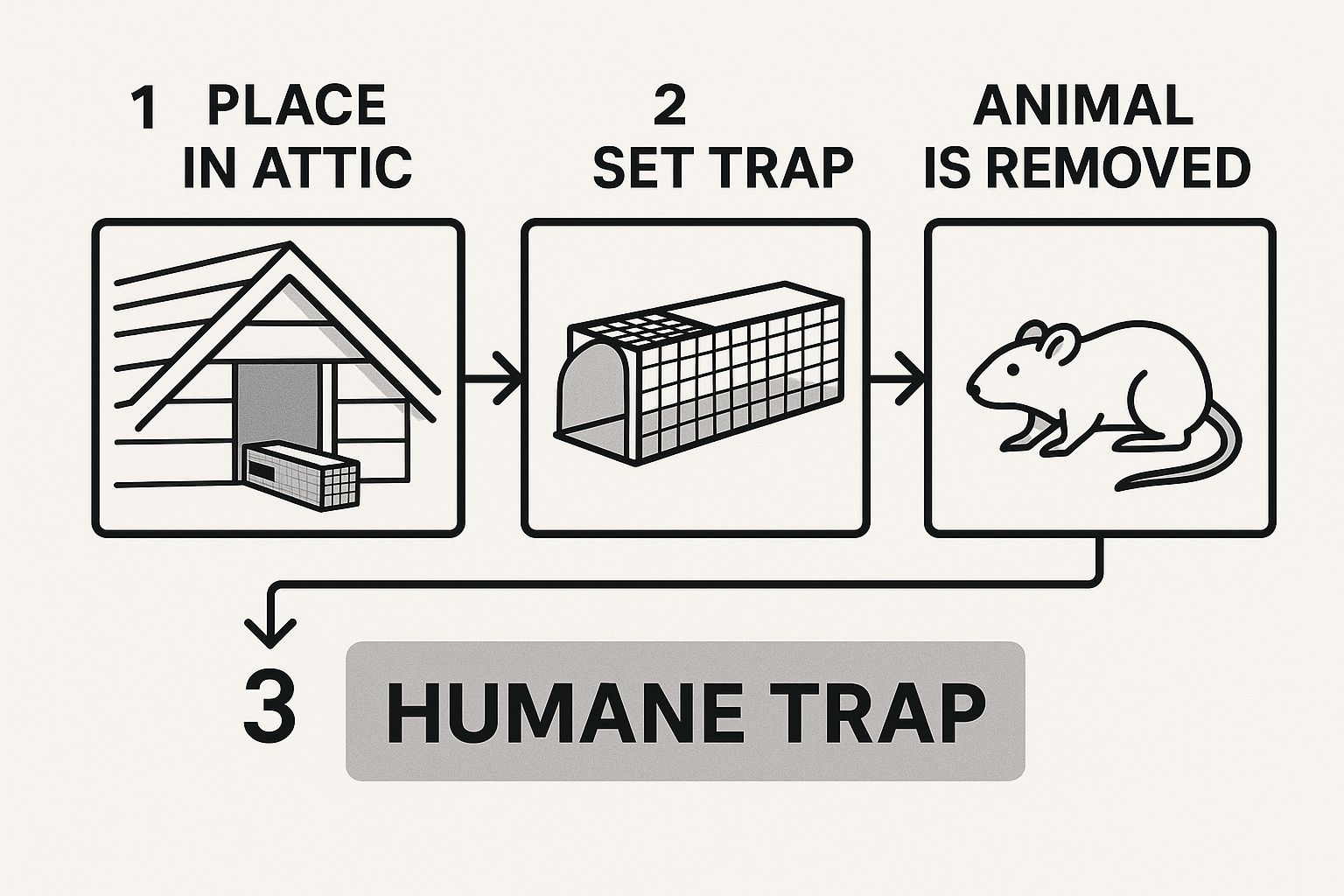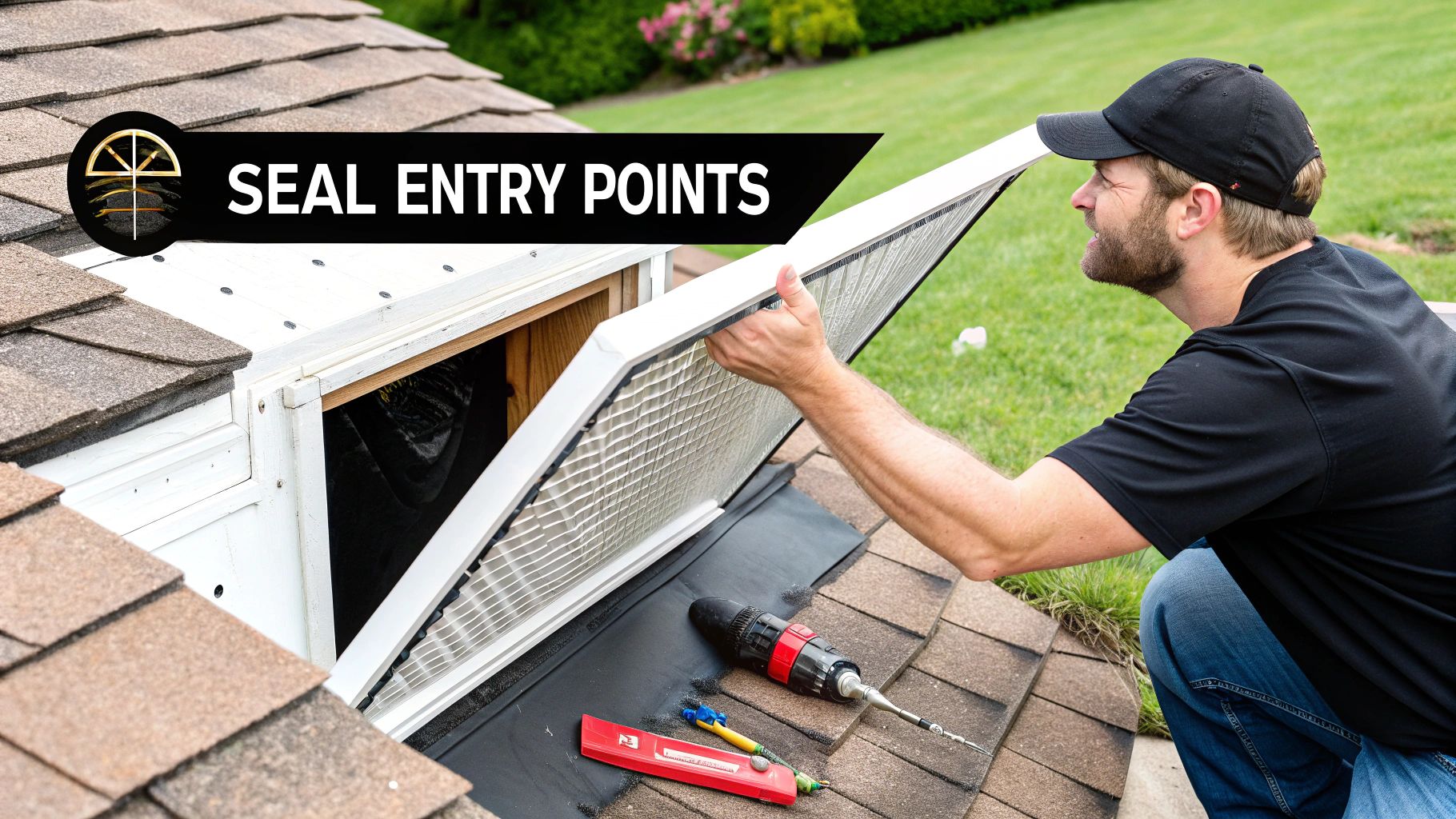Right, before you even think about how to get rid of squirrels in your attic, you need to be absolutely 100% certain that squirrels are the culprits. I’ve seen it time and time again – homeowners waste time and money on the wrong removal methods simply because they misidentified the pest. Getting it right from the start is half the battle.
Confirming You Have a Squirrel Problem

Often, the first sign isn't what you see, but what you hear. Squirrels are creatures of habit, most active during the day. Listen for frantic scurrying, scratching, or even rolling sounds directly above your head in the early morning and late afternoon. That daytime activity is a dead giveaway; nocturnal pests like rats and mice do their work while you’re asleep.
Sounds are a great clue, but a physical inspection of your loft is where you’ll find undeniable proof. You just need to know what you’re looking for.
Telltale Physical Evidence
When you pop your head up into the loft, keep your eyes peeled for these specific signs:
- Shredded Insulation: Squirrels love to tear up and burrow into fibreglass or spray foam insulation. It makes the perfect warm, cosy material for their nests. You’ll see it displaced, flattened, or literally ripped to shreds.
- Gnaw Marks: A squirrel’s teeth never stop growing, so they chew on everything. Look for damage on wooden beams, support rafters, and stored cardboard boxes. Most critically, check electrical wiring – stripped plastic casing is a huge red flag.
- Droppings: Their droppings are quite distinct. They’re larger than mouse or rat droppings, typically 1-2 cm long, with rounded edges. They start off a brownish or reddish colour and fade to a pale brown over time.
- Nesting Debris: Squirrels are messy builders. Finding piles of leaves, twigs, shredded paper, or bits of fabric they’ve dragged in from outside is a clear sign they’ve set up a nest, known as a 'drey'.
With grey squirrel populations on the rise across the UK, reports of property damage have shot up too. It’s something we see constantly in the field. They cause significant harm by gnawing on woodwork and ceilings, but the real danger is their habit of chewing on electrical wiring. You can find more details on the damage squirrels can cause from our pest control colleagues in Nottingham.
Critical Safety Warning: The single biggest risk squirrels introduce is fire. Once they gnaw through the plastic on a cable, the exposed wires can easily spark and ignite dry loft materials like timber and insulation. This threat alone makes getting them out a necessity, not just a preference.
Identifying Your Unwanted Attic Guest
It's easy to mistake one pest for another based on sound alone. This quick comparison table will help you match the evidence you find to the right culprit, ensuring you tackle the problem effectively.
| Sign of Infestation | Squirrel Evidence | Rat Evidence | Bird Evidence |
|---|---|---|---|
| Activity Time | Daytime (morning/late afternoon) | Nocturnal (late at night) | Daytime (chirping at dawn/dusk) |
| Sounds | Fast scurrying, scratching, rolling nuts | Slower gnawing, scratching, squeaking | Chirping, flapping, cooing |
| Droppings | 1-2 cm, rounded ends, scattered | 1 cm, pointed ends, dark, in piles | White splatters, often with seeds |
| Nesting Material | Leaves, twigs, insulation, fabric | Shredded paper, fabric, loft debris | Grass, twigs, feathers, droppings |
| Damage Type | Gnawed wood, wires, entry holes | Greasy rub marks, gnawed pipes/wood | Dislodged tiles, blocked vents |
Once you've confidently identified your uninvited lodger as a squirrel, you can move forward with a removal strategy that will actually work. This certainty is the foundation for successfully reclaiming your loft and protecting your home from serious, costly damage.
Why Squirrels Invade Attics in the First Place
To get rid of squirrels in your attic for good, you first need to think like one. What makes your loft so irresistible? It’s rarely just a random accident; squirrels are driven by powerful, instinctual needs, and your home often provides the perfect five-star solution.
At its core, an attic offers two things a squirrel values above all else: safety and shelter. From a squirrel's point of view, your loft is a predator-proof upgrade to a tree hollow. It's warm, dry, and high above ground-level threats like foxes or the neighbourhood cat. This makes it an ideal spot to sit out the worst of the British weather.
The Seasonal Drive for Shelter
That urge to find a safe haven really kicks into high gear as the seasons change. In the UK, we see a massive spike in attic infestations from grey squirrels, especially as they look for somewhere to ride out the winter. These squirrels don't hibernate, so as autumn arrives with its colder, shorter days, their entire focus shifts to finding a warm, secure den.
This seasonal behaviour puts homes with unsealed roof spaces or damaged vents at high risk. You can find out more about how squirrels' habits change with the seasons by reading about seasonal squirrel behaviour on ArchersPestControl.co.uk.
A Squirrel's Logic: An attic isn't just a temporary hideout. For a pregnant female, it’s the perfect nursery. The quiet, climate-controlled space is an ideal place to build a nest (known as a 'drey') and raise her young, completely hidden from danger. This is exactly why you'll often find piles of shredded loft insulation, leaves, and bits of fabric tucked away in a corner.
Accidental Invitations You Might Be Offering
Without realising it, your home could be rolling out the welcome mat. Squirrels are incredible acrobats and opportunists, and they’re experts at exploiting any weakness you give them.
It's amazing how often an infestation starts with one of these common attractants:
- Overhanging Tree Limbs: We see this all the time. Think of these as personal bridges leading directly to your roof. A squirrel can easily leap from a nearby branch onto your tiles, giving it all the time in the world to scout for an entry point.
- Climbing Plants: Ivy, wisteria, and other climbers growing up the side of a house are basically a natural ladder. They provide easy, discreet access right up to the roofline and eaves.
- Nearby Bird Feeders: While you put them out for the robins and blue tits, these feeders are an all-you-can-eat buffet for squirrels. A reliable food source encourages them to set up a permanent home in the closest secure building—which is often your attic.
By spotting and dealing with these "invitations," you immediately make your home a far less appealing target. Trimming back trees and being clever about where you place bird feeders are fundamental first steps in any effective, long-term prevention plan.
Humanely Getting Squirrels Out of Your Loft
Right, you’ve confirmed you've got squirrels setting up camp in the loft. Now for the eviction. The key here isn't just getting them out; it's getting them out humanely and making sure the door is firmly closed behind them so they can’t just waltz back in. A bit of strategy now will save you a world of trouble later.
Hands down, the best and most ethical way to handle this is with a one-way exclusion door or a professional live-catch trap. We place these right over their main entry point. The device lets the squirrel leave for its daily forage but blocks it from getting back in. It’s a beautifully simple idea, but getting it right is all in the execution.
Pinpointing Their Main Route In
First things first, you need to play detective and find the primary route the squirrels are using. You might have spotted a few gaps during your initial look-around, but they'll almost always have a favourite 'motorway' into your home.
Look for the tell-tale signs of a well-used entrance:
- Fresh gnaw marks around the edges of a hole.
- Greasy, dirty rub marks left by their fur as they squeeze through.
- Little bits of debris like twigs or loft insulation caught around the opening.
Once you're confident you've found the main entrance, you must temporarily block all other potential entry points. You can't leave any back doors open. Use tough materials like steel wire mesh or solid timber to seal any smaller gaps. This forces the squirrel to use the one remaining exit—the one where your trap or one-way door is waiting.
This is exactly what we mean. Placing the device directly over the access point is non-negotiable for it to work.

As you can see, precise placement is everything.
The Big Complication: Baby Squirrels
Before you block anything, you have to think about the time of year. Grey squirrels in the UK have two main breeding seasons: one in late winter/early spring (February to April) and a second in the summer (June to July). If you've got a squirrel in your loft during these times, it’s very likely a mother with a litter of babies.
Blocking an exit when helpless young are inside is a critical mistake. The mother will become frantic and cause immense damage trying to get back to them, and the babies will be left to starve. This is not only incredibly cruel but creates a much worse and more distressing problem for you to deal with.
A female squirrel often seeks out a loft specifically to raise her young in a safe, warm space. Trapping her or blocking her out while she has dependent kits in the nest is a definite no-go. If you even suspect there might be a nest, the best course of action is to either wait a few weeks until the young are mobile enough to leave with their mother or, better yet, call in a professional.
UK Law and When to Call for Help
It's also vital you know where you stand legally. The grey squirrel is listed as an invasive species in the UK. Under the Wildlife and Countryside Act 1981, it is illegal to release a trapped grey squirrel back into the wild. Any that are caught must be humanely dispatched.
This legal requirement alone is a very good reason why calling a professional is the safest, most responsible choice. A trained pest controller knows how to handle the situation legally and ethically. We can ensure the removal is done correctly and, crucially, that your home is properly sealed afterwards to prevent it from happening again.
For a complete, permanent solution, professional rodent control and proofing services are the only way to go.
Fortifying Your Home Against Future Invasions

Getting squirrels out of your attic is a significant victory, but it's only half the battle. If you don't take steps to secure your home, it’s just a matter of time before another opportunistic squirrel discovers the vacancy and moves in. The real goal here is to turn your home into an impenetrable fortress.
This process always starts with a thorough exterior inspection. You have to learn to look at your property through a squirrel’s eyes. Start from the roof and work your way down, scanning for any gap or weakness they could possibly exploit. A squirrel only needs a hole the size of a 50-pence piece to get through, so no gap is too small to ignore.
Your Roofline Inspection Checklist
The roofline is almost always the main point of entry, so it demands the most attention. Here’s what we look for during an inspection:
- Damaged Vents: Check your gable vents, soffit vents, and any roof vents. Look for broken slats, torn mesh screens, or plastic that's been obviously chewed away.
- Gaps in Soffits and Fascias: Take a close look at where the roof meets the walls. Years of weather can cause wooden fascias to rot and soffit panels to warp, creating perfect, sheltered entry points for pests.
- Loose or Missing Tiles: A single dislodged roof slate or tile can create an inviting opening. Pay extra attention to the areas around chimneys and dormer windows, as this is where flashings often become loose.
Once you’ve found these vulnerable areas, the next job is to seal them with materials that can actually withstand a squirrel’s persistent gnawing. Regular fillers and expanding foam just won’t cut it; they’ll chew right through them in minutes. You need materials that defeat their dental determination.
A Pro's Perspective: From experience, we know that if a squirrel can't get back in through its old route, it will immediately start searching for a new one. This is why a comprehensive proofing job is non-negotiable. Sealing just the one main entrance is a short-term fix for a long-term problem.
Choosing the Right Materials
Sealing your home effectively is all about using the right tool for the job. Not all materials are created equal when it comes to stopping a determined rodent. For a more comprehensive overview, you can learn more about our pest control services, which always include detailed proofing work.
To help you get started, here's a quick reference on the most effective materials for sealing common entry points, rated for their durability against some very determined gnawing.
Your Squirrel-Proofing Materials Checklist
| Vulnerable Area | Best Sealing Material | Why It's Effective |
|---|---|---|
| Vents and Large Gaps | Galvanised Steel Mesh | Extremely durable, rust-resistant, and impossible for squirrels to chew through. It also allows for continued airflow. |
| Gaps in Soffits | Metal Flashing | Cut-to-size sheets of metal can be fitted over gaps to create a solid, chew-proof barrier. |
| Cracks and Small Holes | Wire Wool & Epoxy Filler | The combination of abrasive wire wool and hard filler creates a plug that is tough and unpleasant to chew. |
Using these materials will give you a solid, physical barrier against re-entry.
Finally, don’t forget to manage the environment around your home. A crucial step is to trim back any tree limbs that are within 10 feet of your roofline to remove those natural bridges squirrels love to use.
By combining robust physical barriers with smart environmental management, you create multiple layers of defence, ensuring your attic remains a squirrel-free zone for good.
Safely Cleaning and Repairing Your Attic Post-Infestation
Once the squirrels are gone for good, the job isn’t quite finished. You're left with the mess they made, which is more than just an inconvenience—it’s a mix of hazardous waste and physical damage. Cleaning this up properly is crucial, but it has to be done with safety as your number one concern. This isn't a quick sweep with a brush; think of it as a full decontamination.
First things first: you have to protect yourself. Squirrel droppings and urine can be loaded with bacteria and parasites. When you start cleaning, these can easily become airborne, and you don't want to be breathing them in. Never, ever go into a contaminated attic without the right personal protective equipment (PPE).
Your Essential Safety Gear
Before you even think about starting the cleanup, get your kit together. You'll need:
- Disposable Gloves: Essential for keeping waste off your skin.
- P2 or P3 Respirator Mask: This is non-negotiable. It protects your lungs from tiny, harmful particles. A standard paper dust mask just won’t cut it.
- Safety Goggles: Protects your eyes from falling debris and dust clouds.
- Disposable Overalls: Keeps the grime and germs off your clothes.
Once you're suited up, the first task is to get rid of the solid waste and any insulation they've ruined. Carefully bag up all the droppings, old nesting materials, and leftover food scraps into heavy-duty bin bags. If insulation is heavily soiled with urine and faeces, the best and safest option is often to cut it out and dispose of it entirely.
Health and Safety Takeaway: The risks from squirrel waste are very real. While it’s rare, diseases like Leptospirosis can be transmitted through contact with infected urine. Wearing the correct PPE isn't just a recommendation; it's an absolute must for a safe cleanup.
Disinfecting and Repairing the Damage
After clearing out the debris, the entire space needs a deep clean. You’ll want to disinfect every surface—joists, floorboards, and anything else up there. A good quality virucidal cleaner or a simple 1:10 bleach-and-water solution will do the trick. Spray everything down to kill off any lingering bacteria and, just as importantly, to neutralise the scents that might attract other pests in the future.
Now that it’s clean, you can get a clear look at the damage. Squirrels are notorious chewers, so your inspection needs to be thorough. Focus on two main things:
- Structural Wood: Look closely at all the rafters, beams, and joists. Check for any deep gnaw marks that could weaken the timber.
- Electrical Wiring: This is the most critical check of all. You're looking for any wires where the plastic coating has been chewed or stripped away. If you find any sign of electrical damage, don’t even think about touching it. Call a qualified electrician straight away. Frayed wiring is a serious fire hazard that can’t be ignored.
Finally, it’s time to fix the entry points from the inside and replace any insulation you had to remove. This will get your home's energy efficiency back on track. If you sealed up larger gaps outside with steel mesh, you might need to patch up corresponding holes in plasterboard or around vents inside. To permanently stop pests from using air bricks as an easy way in, you can learn more about fitting purpose-built mesh air brick covers. A thorough job like this makes sure your attic isn't just clean, but truly squirrel-proof.
Your Top Questions About Attic Squirrels Answered
Even with a solid game plan, it's natural to have a few questions buzzing around. When you're figuring out how to get rid of squirrels in the loft, a few common worries always pop up. Let's tackle some of the most frequent ones we hear from homeowners in your exact situation.
When Is the Best Time of Year to Remove Them?
Timing your eviction can make a world of difference. The sweet spot is usually late summer or early autumn. By then, any babies born in the spring litter will have grown up and moved on, and the adults haven't quite bunkered down for the winter yet.
Trying to get them out in late spring is a much trickier business. You run the very real risk of trapping a mother squirrel and leaving her helpless young behind to starve. If you think there's an active nest up there, it's often far better to wait a few weeks for the babies to mature or call in a professional who can safely remove the entire family together.
Do DIY Repellents Actually Work?
It’s tempting to grab a quick fix off the shelf, like an ultrasonic sound device or some strong-smelling spray. I get it, but from my experience, these methods almost never deliver a lasting solution.
- Ultrasonic Devices: The high-frequency sound they blast out is easily muffled by all the stuff in your loft. Insulation, wooden beams, and storage boxes block the waves, making them pretty useless in a cluttered space.
- Scent-Based Repellents: Things like mothballs, rags soaked in ammonia, or even peppermint oil might annoy a squirrel for a day or two, but they get used to the smell incredibly quickly. It’s just not a strong enough motivator to make them abandon a warm, dry, and safe home.
Here's the hard truth: Repellents are a plaster on a broken bone. The only way to guarantee a long-term fix is to get the squirrels out and then physically block every single entry point with materials they can't chew through.
Can I Legally Relocate a Grey Squirrel in the UK?
This is a huge one, and something many people don't realise. Here in the UK, the grey squirrel is classified as an invasive, non-native species. Under the Wildlife and Countryside Act 1981, it is illegal to trap a grey squirrel and release it back into the wild.
That means if you catch one, you can't just drive it down the road and let it go. It must be humanely dispatched. This law is precisely why DIY trapping is so loaded with legal and ethical pitfalls. Using a licensed and trained pest controller ensures everything is handled legally, humanely, and correctly.
How Much Will Professional Squirrel Removal Cost?
The cost for a professional to come in and sort out your squirrel problem can vary. It really depends on how bad the infestation is, how many entry points need to be sealed up, and where you are in the UK.
As a ballpark figure, a basic service for an inspection and setting the initial traps might start from around £150-£250. For a more comprehensive job that includes humane removal, thorough proofing work to seal all the gaps, and a bit of a clean-up, you could be looking at a cost between £300 to over £600. Always make sure you get a detailed, itemised quote so you know exactly what you're paying for.
Tackling a squirrel infestation properly takes experience, the right equipment, and a solid understanding of squirrel behaviour and UK law. If you want the job done right the first time, our team at Pest Predators Limited is here to help. We use our knowledge of biology and years of practical experience to give you a permanent solution, not just a temporary patch. Contact us today for a consultation and get your peace of mind back.



